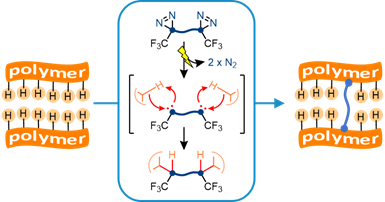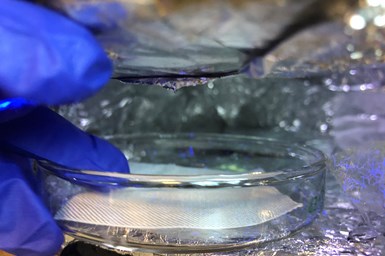XlynX Materials releases new polymer molecular glue: BondLynx
"Hyper glue" adhesive forges new bonds at the molecular level to permanently adhere difficult-to-bond polymers.
BondLynx employs bis-diazirine chemistry to create covalent chemical bonds between polymer chains, permanently crosslinking them together through strong carbon-carbon bonds. BondLynx molecular glues can also be applied to polymer textiles to link and strengthen the fibers. Photo Credit: XlynX Materials
XlynX Materials (Victoria, B.C., Canada) has announced the creation of a new class of adhesives they are calling “molecular glues.” These make it possible to permanently adhere difficult-to-bond polymers such as polyethylene and polypropylene to themselves, and to other materials, through exceptionally strong chemical bonds.

BondLynx creates covalent chemical bonds between polymer chains, permanently crosslinking them together through strong carbon-carbon bonds — the same type of joinery found between carbon atoms in the polymer chains themselves. Photo Credit: XlynX Materials
Conventional adhesives typically take advantage of mechanical forces to hold materials together. BondLynx employs bis-diazirine chemistry to create covalent chemical bonds between polymer chains, permanently crosslinking them together through strong carbon-carbon bonds — the same type of joinery found between carbon atoms in the polymer chains themselves. Once BondLynx has been applied to a polymer, the crosslinking process can be initiated by heat, ultraviolet (UV)/visible light or an electric field, depending on the specific demands of the manufacturing process.
"What's really amazing about BondLynx is that it can ‘glue’ virtually any plastic to any other plastic,” says Jeremy Wulff, professor of Organic Chemistry at the University of Victoria. “BondLynx acts by inserting itself into the carbon-hydrogen bonds that are present in almost every commodity polymer. The potential applications are limitless."
has undergone adhesive testing on a wide range of polymer and polymer-metal combinations. Remarkably, even elastomers and damp surfaces can be bonded with BondLynx, opening broad opportunities for novel applications, for example, in the medical field.
Strengthening of fabrics

Application of BondLynx molecular glue to strengthen fabric. Photo Credit: XlynX Materials
In addition to being used directly as polymeric adhesives, BondLynx molecular glues can be applied to polymer textiles to link and strengthen the fibers. It has proven effective in strengthening ultra-high molecular weight polyethylene (UHMWPE) fabrics for ballistics protective equipment and wind sport applications.
“As a leading manufacturer of body armor products, PRE Labs had a privilege to test and use ultra-high performance fabrics crosslinked with BondLynx,” explains PRE Labs CEO Brad Field. “Our evaluations to date have confirmed that these new-generation cross-linking agents can significantly enhance the tear and perforation resistance along with mechanical properties of high-performance fabrics.” Researchers at the University of British Columbia, University of Alberta, McGill University and industry labs have already begun similar testing.
Further information
Samples for testing and research purposes are now available from XlynX Materials. Please send your request to info@xlynxmaterials.com. For a deeper look at the science behind this new technology, see: “” in Science and “” in Chemical Science.
About BondLynx
BondLynx is a revolutionary new type of adhesive that takes advantage of chemical crosslinking to form ultra-strong covalent bonds between a wide range of “impossible to bond” polymers and other materials.
About XlynX Materials Inc.
XlynX (pronounced “ex-links”) is a rapidly-emerging specialty chemical company focusing on the development of novel diazirine-based crosslinking molecules, carbon materials, and the combination of both technologies to provide solutions to the world’s toughest composite materials challenges. Located on Canada’s west coast, XlynX’s team of chemists and physicists is committed to working with researchers around the world to bring new and exciting chemical products to market. XlynX Materials gratefully acknowledges the financial support of the Mitacs Accelerate program.
Related Content
The potential for thermoplastic composite nacelles
Collins Aerospace draws on global team, decades of experience to demonstrate large, curved AFP and welded structures for the next generation of aircraft.
Read MoreOtto Aviation launches Phantom 3500 business jet with all-composite airframe from Leonardo
Promising 60% less fuel burn and 90% less emissions using SAF, the super-laminar flow design with windowless fuselage will be built using RTM in Florida facility with certification slated for 2030.
Read MoreActive core molding: A new way to make composite parts
Koridion expandable material is combined with induction-heated molds to make high-quality, complex-shaped parts in minutes with 40% less material and 90% less energy, unlocking new possibilities in design and production.
Read MoreThe next evolution in AFP
Automated fiber placement develops into more compact, flexible, modular and digitized systems with multi-material and process capabilities.
Read MoreRead Next
Scaling up, optimizing the flax fiber composite camper
Greenlander’s Sherpa RV cab, which is largely constructed from flax fiber/bio-epoxy sandwich panels, nears commercial production readiness and next-generation scale-up.
Read MoreUltrasonic welding for in-space manufacturing of CFRTP
Agile Ultrasonics and NASA trial robotic-compatible carbon fiber-reinforced thermoplastic ultrasonic welding technology for space structures.
Read MoreCeramic matrix composites: Faster, cheaper, higher temperature
New players proliferate, increasing CMC materials and manufacturing capacity, novel processes and automation to meet demand for higher part volumes and performance.
Read More












